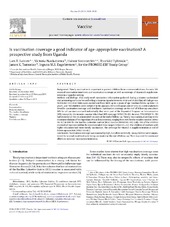Is vaccination coverage a good indicator of age-appropriate vaccination? A prospective study from Uganda
| dc.contributor.author | Fadnes, Lars Thore | en_US |
| dc.contributor.author | Nankabirwa, Victoria | en_US |
| dc.contributor.author | Sommerfelt, Halvor | en_US |
| dc.contributor.author | Tylleskär, Thorkild | en_US |
| dc.contributor.author | Tumwine, James K. | en_US |
| dc.contributor.author | Engebretsen, Ingunn Marie S. | en_US |
| dc.date.accessioned | 2015-04-16T09:15:22Z | |
| dc.date.available | 2015-04-16T09:15:22Z | |
| dc.date.issued | 2011-04-27 | eng |
| dc.identifier.issn | 0264-410X | |
| dc.identifier.uri | https://hdl.handle.net/1956/9804 | |
| dc.description.abstract | Background: Timely vaccination is important to protect children from common infectious diseases. We assessed vaccination timeliness and vaccination coverage as well as coverage of vitamin A supplementation in a Ugandan setting. Methods and findings: This study used vaccination information gathered during a cluster-randomized trial promoting exclusive breastfeeding in Eastern Uganda between 2006 and 2008 (ClinicalTrials.gov no. NCT00397150). Five visits were carried out from birth up to 2 years of age (median follow-up time 1.5 years), and 765 children were included in the analysis. We used Kaplan–Meier time-to-event analysis to describe vaccination coverage and timeliness. Vaccination coverage at the end of follow-up was above 90% for all vaccines assessed individually that were part of the Expanded Program on Immunization (EPI), except for the measles vaccine which had 80% coverage (95%CI 76–83). In total, 75% (95%CI 71–79) had received all the recommended vaccines at the end of follow-up. Timely vaccination according to the recommendations of the Ugandan EPI was less common, ranging from 56% for the measles vaccine (95%CI 54–57) to 89% for the Bacillus Calmette–Guérin (BCG) vaccine (95%CI 86–91). Only 18% of the children received all vaccines within the recommended time ranges (95%CI 15–22). The children of mothers with higher education had more timely vaccination. The coverage for vitamin A supplementation at end of follow-up was 84% (95%CI 81–87). Conclusions: Vaccination coverage was reasonably high, but often not timely. Many children were unprotected for several months despite being vaccinated at the end of follow-up. There is a need for continued efforts to optimise vaccination timeliness. | en_US |
| dc.language.iso | eng | eng |
| dc.publisher | Elsevier | eng |
| dc.rights | Attribution-NonCommercial-NoDerivs CC BY-NC-ND | eng |
| dc.rights.uri | http://creativecommons.org/licenses/by-nc-nd/3.0/ | eng |
| dc.subject | Immunisation | eng |
| dc.subject | Mass vaccination | eng |
| dc.subject | Vaccination timeliness | eng |
| dc.subject | Vaccination coverage | eng |
| dc.subject | Uganda | eng |
| dc.subject | Sub-Saharan Africa | eng |
| dc.title | Is vaccination coverage a good indicator of age-appropriate vaccination? A prospective study from Uganda | en_US |
| dc.type | Peer reviewed | |
| dc.type | Journal article | |
| dc.date.updated | 2015-04-01T07:09:06Z | en_US |
| dc.description.version | publishedVersion | en_US |
| dc.rights.holder | Copyright 2011 Elsevier Ltd. | |
| dc.identifier.doi | https://doi.org/10.1016/j.vaccine.2011.02.093 | |
| dc.identifier.cristin | 835653 | |
| dc.source.journal | Vaccine | |
| dc.source.40 | 29 | |
| dc.source.14 | 19 | |
| dc.source.pagenumber | 3564-3570 | |
| dc.subject.nsi | VDP::Medical sciences: 700::Health sciences: 800::Preventive medicine: 804 | eng |
| dc.subject.nsi | VDP::Medisinske fag: 700::Helsefag: 800::Forebyggende medisin: 804 | nob |

